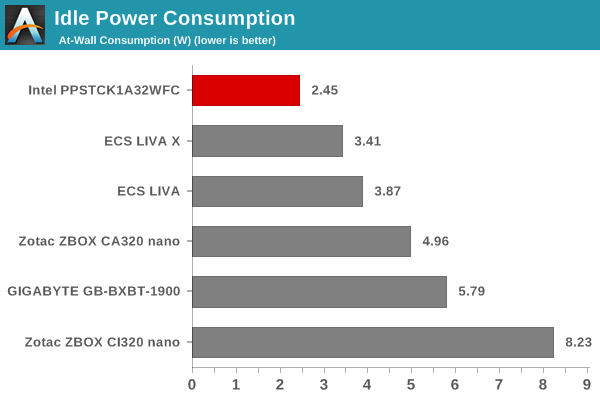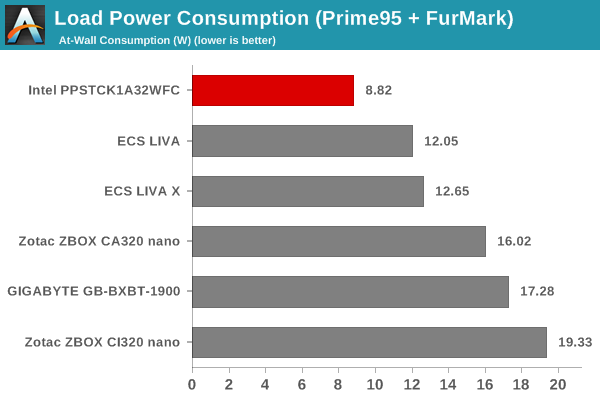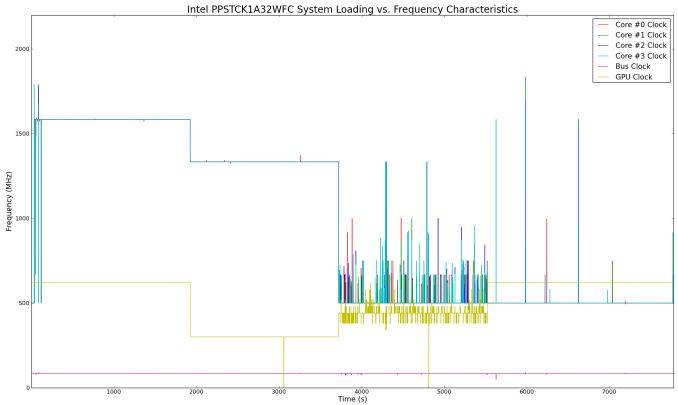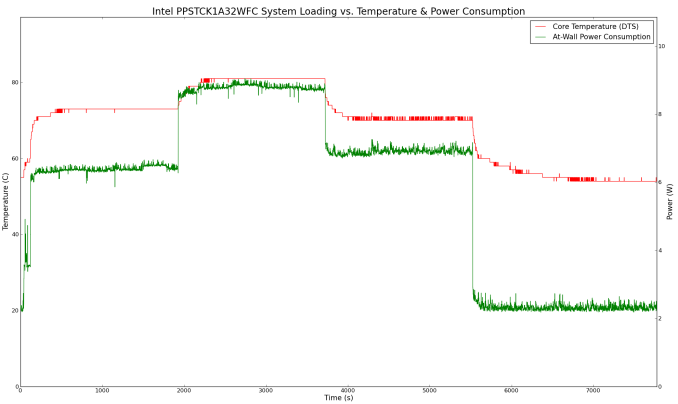Intel PPSTCK1A32WFC Bay Trail-T Compute Stick Review
by Ganesh T S on April 22, 2015 11:00 AM EST- Posted in
- Systems
- Intel
- Bay Trail
- HDMI Stick
Power Consumption and Thermal Performance
The power consumption at the wall was measured with a 1080p display being driven through the HDMI port. In the graphs below, we compare the idle and load power of the Intel PPSTCK1A32WFC with other low power PCs evaluated before. For load power consumption, we ran Furmark 1.12.0 and Prime95 v27.9 together. The numbers track what one might expect from the combination of hardware components in the machine.


It is not a surprise (given the tablet platform that is inside the Compute Stick) that the unit proves to be the least power-hungry of the lot.
Our thermal stress routine starts with the system at idle, followed by 30 minutes of pure CPU loading. This is followed by another 30 minutes of both CPU and GPU being loaded simultaneously. After this, the CPU load gets removed, allowing the GPU to be loaded alone for another 30 minutes. The various clocks in the system throughout this routine are presented in the graph below.
The cores burst up to 1.83 GHz for a few seconds, before settling down to 1.58 GHz during the pure CPU loading process. The core temperature plateaus around 76 C, while power consumption at the wall is slightly more than 6 W. With thee GPU also loaded, the temperature reaches 80 and the power consumption is closer to 9 W. However, the CPU and GPU frequencies adjust themselves to be within the power budget. The cores run at 1.3 GHz while the GPU is clocked at slightly more than 300 MHz. Removing the CPU load brings temperatures back to 75 C and power consumption to less than 7 W. The CPU cores idle at 500 MHz, while the GPU clocks in around 440 MHz.
It is a very effective thermal solution and the temperatures do not raise any alarm. The presence of active cooling definitely helps in this situation.












103 Comments
View All Comments
Arnulf - Wednesday, April 22, 2015 - link
Looks like a massive fail, but then again what else to expect from such a small form factor ...kyuu - Wednesday, April 22, 2015 - link
If you think this is a "massive fail", the problem is probably more your expectations than the product.jospoortvliet - Wednesday, April 22, 2015 - link
Or he's comparing it to the competition... Chromecast for one. It might not be as powerful but what it does it does well - without an annoying fan or bad/unreliable wifi. And at a very low price.Yeah, this doesn't impress me either, mostly due to the failure to make this fanless. The drive size is fine (put Linux with Kodi on it) but the bad wlan - that is a fail, too.
Still, yeah, first gen, Intel is good at incremental improvement so I bet gen 2 will be much much better.
JeffFlanagan - Wednesday, April 22, 2015 - link
This isn't something comparable to a Chromecast. Chromecast is an extremely limited device. I've already replaced one with a much more capable Fire stick, and may replace the other with one of these or another low power PC.usernametaken76 - Wednesday, April 22, 2015 - link
I'm going to have to agree with you on that, Jeff. This does what they say it does, and it runs Windows. So you can build and compile your own local applications and there's no need for a "network" operating system like ChromeOS. For some users, that's what they want and/or need. You could easily build a Plex server and run the Plex app on this device and be quite happy, I'll assume. It would be nice to have more of a "user experience" review. Performance metrics are interesting, but if I spend $150 on an HDMI stick, I don't care how fast it can encode video, decrypt files, etc. I care how it will perform as a media streamer, can it run any games (highly limited here), can it be a remote streamer for Steam (unlikely for this first gen device), etc. That's what matters to me for something like this.Deelron - Wednesday, April 22, 2015 - link
The first thing I thought when I saw it was Plex server, but the networking solution isn't sufficient enough in my book. While I guess you could add a USB to Ethernet dongle (or thumb wireless solution), that seems kludgey at best. It's an interesting step towards something more usable in the future.usernametaken76 - Wednesday, April 22, 2015 - link
If you mean "Plex client" with the server running elsewhere, then I think its existing wireless is already sufficient. Plex "tops out" at 20 Mbps for streaming, and that's adjustable in the client all the way down to sub HD speeds < ~3 Mbps. You have the option to transcode everything on the Plex server when doing this, and Intel's stick here would be more than capable of handling that situation, provided there's not a lot of WiFi interference on the 2.4 GHz band. If it's 5 Ghz (admit I didn't read the full specs) then less so, but distance is the issue.bigkev1978 - Wednesday, April 22, 2015 - link
Massive fail seems like a bit harsh... I will admit that I haven't used the Compute Stick but I have had a Hannspree Micro PC (www.stickpcstore.com/stick-pcs/hannspree-windows-8-stick-pc-quad-core-1-83-ghz-2gb-ram-32gb-windows-8-1-micro-pc-snnpdi1b.html) for a couple of months and it is very similar spec to the Compute Stick... and it is great... yes it is not an i5 or i7 PC... but it does "light productivity" really well... Word, Excel, Outlook... browsing the web. I've got in plugged into my front room TV (42") and use it occasionally all the time. I agree the WiFI could be better but hopefully this will be a second gen update.Refuge - Wednesday, April 22, 2015 - link
I was reading MAXPC's review, its up on their site. They don't obviously offer the kind of solid quantifiable metrics that I get here, but they are usually good for a user experience overview.They said that it streamed everything from YouTube, Netflix, Hulu to steam in home perfectly. Playing games with no noticeable input lag, and that it streamed 1080p videos without a problem.
The way they described the fan, is that it was just a high pitched hum that you wouldn't hear unless you were in a dead silent room, which is something that I would never deal with if this were on my living Room TV.
They said they got something like 20 FPS on Portal 1 playing it from the stick itself.
azazel1024 - Wednesday, April 22, 2015 - link
I am a little dissapointed (especially the neutered GPU chops, even compared to other Baytrail SoCs), but at the same time, it seems like it would make a perfectly good LIGHT HTPC. I am not super interested this time around, but if the price stays the same, I might be very interested with Cherry Trail if the drop in process size helps out with maintaining higher frequencies under load, better GPU, etc.